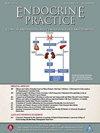Moving Beyond Glycated Hemoglobin to Glucose Patterns: Newer Indications for Continuous Glucose Monitor Use
IF 3.7
3区 医学
Q2 ENDOCRINOLOGY & METABOLISM
引用次数: 0
Abstract
Glucose homeostasis is a constant process involving several physiological mechanisms. Estimation of glucose via continuous glucose monitor (CGM) sensors provides a 24-hour comprehensive evaluation of glycemic excursions, enabling a closer understanding of the underlying defective mechanisms beyond current biomarkers of glycemia, focusing on the impact of glucose exposure, and not on the constant changes. CGM use in type 2 diabetes has shown to have a beneficial effect in improving glycated hemoglobin and time spent in range of 70-180 mg/dL. Some studies have also shown a legacy effect of CGM use after its discontinuation. Use of CGM in various other conditions such as end stage kidney disease, obstructive sleep apnea, gastroparesis, postbariatric hypoglycemia, and insulinoma has been shown to fill the diagnostic and therapeutic void. The advent of new glycemic metrics with the coming of CGM also improves our pathophysiological understanding of such diseases in the context of more readily available glycemic data. As future studies continue to emerge demonstrating the benefits of CGM in conditions other than diabetes; a frameshift focus on the value of constant glucose assessment and not on point-in-time metrics is necessary. Understanding and changing our approach to glycemic excursion will be pivotal for use of CGM beyond traditional indications and improve patient outcomes and quality of life metrics.
从糖化血红蛋白转向葡萄糖模式:CGM应用的新适应症。
葡萄糖稳态是一个涉及多种生理机制的恒定过程。通过连续血糖监测仪(CGM)传感器对血糖的估计提供了24小时血糖漂移的综合评估,使我们能够更深入地了解潜在的缺陷机制,而不是当前血糖的生物标志物,重点关注葡萄糖暴露的影响,而不是持续变化。在2型糖尿病中使用CGM对改善HbA1c和在70-180 mg/dL范围内停留的时间有有益作用。一些研究也显示了停用CGM后的遗留效应。CGM用于其他各种疾病,如终末期肾病、阻塞性睡眠呼吸暂停、胃轻瘫、减肥后低血糖和胰岛素瘤,已被证明可以填补诊断和治疗空白。随着CGM的出现,新的血糖指标的出现也提高了我们在更容易获得血糖数据的背景下对这些疾病的病理生理学理解。随着未来的研究不断涌现,证明CGM在糖尿病以外的疾病中的益处;有必要对恒定葡萄糖评估的价值进行转移,而不是对时间点指标进行转移。理解和改变我们的血糖漂移方法对于超越传统适应症使用CGM并改善患者预后和生活质量指标至关重要。
本文章由计算机程序翻译,如有差异,请以英文原文为准。
求助全文
约1分钟内获得全文
求助全文
来源期刊

Endocrine Practice
ENDOCRINOLOGY & METABOLISM-
CiteScore
7.60
自引率
2.40%
发文量
546
审稿时长
41 days
期刊介绍:
Endocrine Practice (ISSN: 1530-891X), a peer-reviewed journal published twelve times a year, is the official journal of the American Association of Clinical Endocrinologists (AACE). The primary mission of Endocrine Practice is to enhance the health care of patients with endocrine diseases through continuing education of practicing endocrinologists.
 求助内容:
求助内容: 应助结果提醒方式:
应助结果提醒方式:


